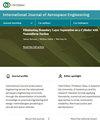PSiamRML: Target Recognition and Matching Integrated Localization Algorithm Based on Pseudo-Siamese Network
IF 1.2
4区 工程技术
Q3 ENGINEERING, AEROSPACE
引用次数: 0
Abstract
The positioning function of unmanned aerial vehicles (UAVs) is a challenging and fundamental research topic and is the premise for UAVs to realize autonomous navigation. The disappearance of satellite signals makes it challenging to achieve accurate positioning. Thus, visual positioning algorithms based on computer vision have been proposed in recent years and these algorithms have produced good results. However, these algorithms have relatively simple functions and cannot perceive the environment. Their versatility is poor, and mismatching often occurs, which affects the positioning accuracy. Aiming to address the need for integrated target recognition, target matching, and positioning of UAVs, we propose an algorithm that integrates the target recognition, matching, and positioning functions by combining the single-shot multibox detector (SSD) algorithm with the deep feature matching algorithm. This algorithm is based on the idea of pseudo-Siamese networks and the SSD algorithm, introducing a deep feature matching method to directly calculate the correspondence between two images. The main idea is to use the VGG network trained by the SSD target recognition algorithm to extract deep features, without any special training for feature matching. Finally, by sharing neural network weights, the integrated design of target recognition and image-matching localization algorithms is achieved. Mismatches between the real-time and reference images are addressed by introducing the grid-based motion statistics algorithm to optimize the matching result and improve the correct matching efficiency of the target. The University-Release dataset was used to compare and analyze the performance of the proposed algorithm to verify its superiority and feasibility. The results show that the matching accuracy of the PSiamRML algorithm is generally good and that it significantly compensates for changes in the contrast, scale, brightness, blur, deformation, and so on, apart from improving the stability and robustness. Finally, a matching test scenario with aerial images captured by an S1000 six-rotor UAV served to verify the effectiveness and practicability of the PSiamRML algorithm.PSiamRML:基于伪暹罗网络的目标识别与匹配集成定位算法
无人机的定位功能是一个具有挑战性和基础性的研究课题,是无人机实现自主导航的前提。卫星信号的消失给精确定位带来了挑战。因此,近年来提出了基于计算机视觉的视觉定位算法,并取得了良好的效果。然而,这些算法功能相对简单,无法感知环境。其通用性较差,经常出现不匹配现象,影响定位精度。针对无人机对目标识别、目标匹配和定位一体化的需求,提出了一种将单镜头多盒探测器(SSD)算法与深度特征匹配算法相结合的目标识别、匹配和定位一体化算法。该算法基于伪暹罗网络的思想和SSD算法,引入了一种深度特征匹配方法,直接计算两幅图像之间的对应关系。其主要思想是利用SSD目标识别算法训练的VGG网络提取深度特征,不需要进行特征匹配的特殊训练。最后,通过共享神经网络权值,实现了目标识别和图像匹配定位算法的集成设计。通过引入基于网格的运动统计算法,解决了实时图像与参考图像的不匹配问题,优化了匹配结果,提高了目标的正确匹配效率。利用University-Release数据集对所提算法的性能进行了对比分析,验证了所提算法的优越性和可行性。结果表明,PSiamRML算法的匹配精度总体较好,在提高稳定性和鲁棒性的同时,显著补偿了对比度、尺度、亮度、模糊、变形等方面的变化。最后,通过与S1000六旋翼无人机航拍图像的匹配测试场景,验证了PSiamRML算法的有效性和实用性。
本文章由计算机程序翻译,如有差异,请以英文原文为准。
求助全文
约1分钟内获得全文
求助全文
来源期刊

International Journal of Aerospace Engineering
ENGINEERING, AEROSPACE-
CiteScore
2.70
自引率
7.10%
发文量
195
审稿时长
22 weeks
期刊介绍:
International Journal of Aerospace Engineering aims to serve the international aerospace engineering community through dissemination of scientific knowledge on practical engineering and design methodologies pertaining to aircraft and space vehicles.
Original unpublished manuscripts are solicited on all areas of aerospace engineering including but not limited to:
-Mechanics of materials and structures-
Aerodynamics and fluid mechanics-
Dynamics and control-
Aeroacoustics-
Aeroelasticity-
Propulsion and combustion-
Avionics and systems-
Flight simulation and mechanics-
Unmanned air vehicles (UAVs).
Review articles on any of the above topics are also welcome.
 求助内容:
求助内容: 应助结果提醒方式:
应助结果提醒方式:


